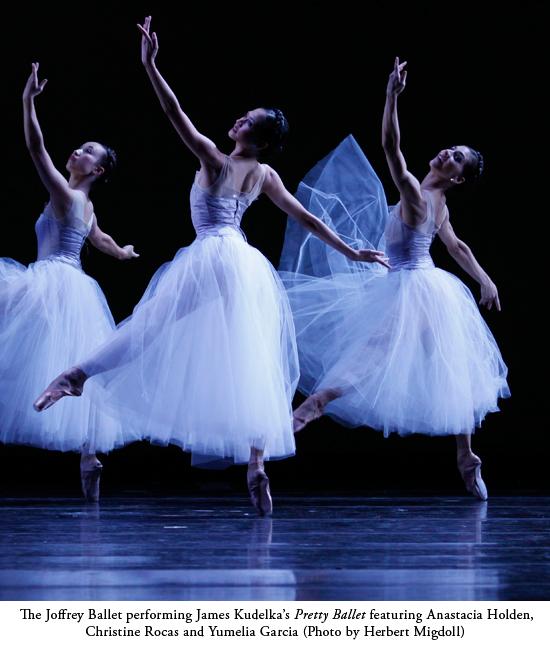
Scott Speck has conducted a lot of great orchestras in a lot of the world's great concert halls, often to extraordinary reviews. The San Francisco Chronicle called his conducting "magical in its balance of purely musical and extramusical values", and in Moscow, Pravda said that "his sure, free and expressive style of conducting" impressed the Russian orchestra and audience alike. This week and next Scott Speck will be conducting the Chicago Philharmonic at the Auditorium Theatre for the Joffrey Ballet's "Human Landscapes" Series, which runs from October 17 through the 28th. He's the Joffrey's Music Director, and as he talks about the Joffrey's commitment to present live music at all of their home performances, he's both informative and convincing. "There's no substitute for the sound that live musicians create," he says, "It's incredibly beautiful."

As he describes the complex process of preparing for such a performance, it becomes more and more clear that the luxurious and powerful sound of a symphony orchestra is only the beginning of the story. At least as important are the myriad ways that music and choreography can expand their magic when they are performed in the same place at the same time. When Speck conducts the Chicago Philharmonic at a Joffrey Performance, an entirely new range of interaction becomes possible, not only between the music and the dancers, but in many ways, between the dancers and the audience.
It's a formidable undertaking, though, and the Joffrey's commitment to its accomplishment is as significant as it is bold. Speck sees it as consistent not only with the Joffrey's unique history, but also with the leadership that Joffrey Artistic Director Ashley Wheater has brought to the Company. "The Joffrey Ballet is a legendary company with a uniquely American history, but it is Artistic Director Ashley Wheater who has brought it to the very highest level," Speck says. "He does this through a strategic mix of challenging programming, astute technical instruction, and a bold vision for the company." An important part of that vision is an understanding of what the richly inspiring reality of a full orchestra brings to the Joffrey's performances, and to their audience.
At least as challenging as the strategic decision is the actual real-time process of making that decision work. A stage full of immensely talented artists move together through an intricately designed choreographic architecture, the structure of which is rhythmic and musical. That structure has to be constructed in real time by another group of immensely talented artists, playing together not only in precise harmony and with perfect rhythmic accuracy, but together bringing all of the emotion of the musical score to the dancers and to the audience. As intricate as their cooperation needs to be, the dancers cannot watch the musicians, and the musicians can't even see the dancers.
"I'm the only one who can see them all," Speck explains, while describing this remarkable process. It begins as soon as the dancers are familiar enough with the choreography to rehearse sections of several minutes. At that stage, they begin rehearsing to extended passages of the music, which in many cases will be a solo piano version of the full score. Even then, Speck begins to sculpt the fine points of the ultimate performance. "Sometimes I'll conduct the piano in rehearsal," he explains, "to make sure that I'm providing the most helpful tempo for the dancers." It's a series of intricate and detailed judgments that he's assembling and rehearsing, because in performance in front of a packed Joffrey house, he will be the focal point of an immense gathering of dancers and musicians, communicating in real time with each of them as they perform.
Bringing all of that to the individual moments of a Joffrey Performance is an astonishing study in the mastery of details. "I see my job as a conductor in ballet as a master communicator between the stage and the orchestra pit," he says. Exactly how he does that varies across a broad spectrum of circumstances and possibilities; what doesn't vary is Speck's attention to the details of the work being performed, and to the individual artists who rely on his direction. "I try to make the musical importance both audible and visible to the dancers," he says. Similarly, as part of preparing for a concert, he provides each of the musicians with videos of the work so that they know what their performance will mean to the dancers and to the audience. "I want them to imagine the lift that is happening to a particular musical passage, and simultaneously, I want the dancers to be able to appreciate the excitement and power of the music."
When he and his colleagues bring it all together, the effect can be immensely enriching to a performance. For example, the same role may be performed by a different cast on different evenings, and Speck will adjust tempo and timing to whatever is best for each individual performer. If a dancer is able to hold a difficult, breathtaking position especially gracefully, he can hold back an entire orchestra for an extra few moments to let her do so. If a couple is especially energetic in their pas de deux, he can match the energy of the music to their performance.
"In so, so many ways," Speck says, "live music is infinitely better than recorded music." He knows that because he's right in the middle of an amazing coalescence of artistry. The Joffrey dancers, costumed and lit and shockingly talented, are like a rock concert for the eyes; the Chicago Philharmonic, unlit and unseen as they perform some of the most beautiful music ever written, are like choreography for the soul. When it all comes together in real time, it's a lavish, nonstop series of breathtaking, multidimensional moments in dance.
This article originally appeared at 4dancers.org
